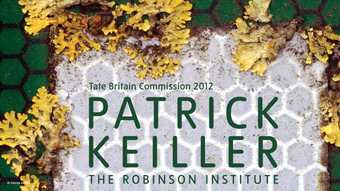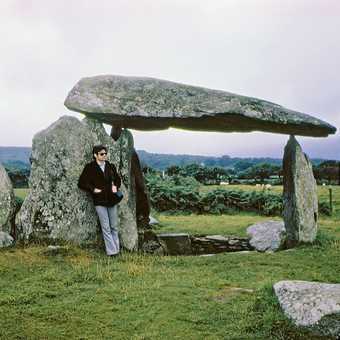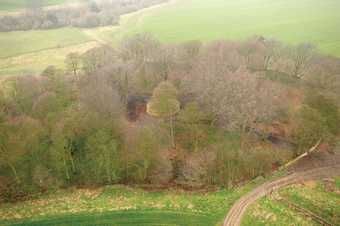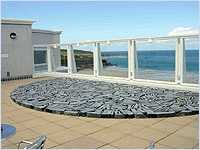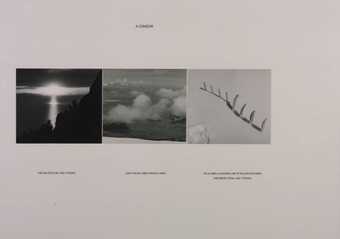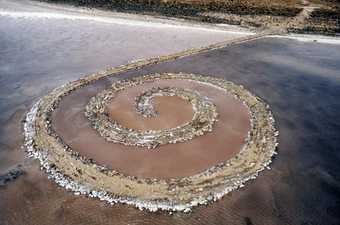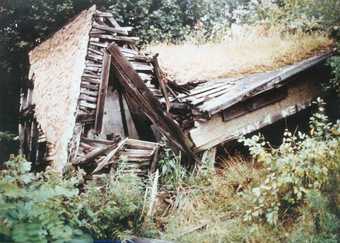The group of articles devoted to the theme of art and environment in Tate Papers no.17 aims to explore new research frontiers between visual art and the material environment. The papers arise from a conference held at Tate Britain in June 2010 at which a range of practitioners and scholars – artists, writers, curators, theorists, historians and geographers – presented case studies of artworks addressing specific sites, spaces, places and landscapes in a variety of media, including film, photography, painting, sculpture and installation. The conference considered relations between artistic approaches to the environment and other forms of knowledge and practice, including scientific knowledge and social activism. The papers addressed cultural questions of weather and climate, ruin and waste, dwelling and movement, boundary and journey, and reflected on the way the environment is experienced and imagined and on the place of art in the material world.
Held at a time when the emergent effects of economic crisis were intersecting with a more established sense of ecological crisis, the conference offered an opportunity to rethink the relations between art and environment, which had become central to a number of art exhibitions and publications. These included in 2009 Radical Nature: Art and Architecture for a Changing Planet 1969–2009 at the Barbican Art Gallery and Earth: Art of a Changing World at the Royal Academy, both in London.1 Conference contributors took the opportunity to reframe relations between art and environment critically and creatively, with a broad historical and geographical perspective that considered artworks from the eighteenth century to the present.
The ‘Art & Environment’ conference was organised by the Arts and Humanities Research Council Landscape and Environment programme. This is one of a set of AHRC thematic programmes supporting research fields of wide cultural and public value as well as academic scholarship and creative practice. The AHRC is distinctive internationally in supporting various forms of practice as well as scholarship – including curating and conserving artworks and archives as well as creating work of all kinds – and funds projects at museums, galleries and libraries, as well as higher education institutions, often in collaborative partnership with each other. One of the programme’s major projects was hosted at Tate Britain, ‘The Sublime Object’, a project that produced a series of its own conference findings published in issues 13 and 14 of Tate Papers.
The ‘Art & Environment’ conference was intended to be exploratory and to further research on art and environment in terms of methods and perspectives as well as subject matter, and in terms of research process and practice as well as product and outcomes. Contributors explored the changing meaning of ‘environment’ in art practice and the different ways it was encountered. They addressed, and some themselves undertook, different kinds of journeying, both epic and eccentric, which confronted and crossed various kinds of boundary, physical and symbolic, material and immaterial. The journeys represented in the conference talks were historical as well as geographical, travels through time as well as space, many reflecting on issues of environmental decline and degradation, some journeys through ruins. They intersected with longstanding journeying traditions of landscape art and aesthetics, encountering romantic and picturesque ruins and speculating on the wider processes of social and environmental transformation, from the ruins of empire to the regeneration of nature. Here were travels through the real and imagined worlds of the recent past and the longest imaginable time, both close to home and to the very ends of the earth.
Changing environments
The journeys, undertaken by both artists and historians, were sometimes to make new work, or conducted in the spirit of re-enactment or pilgrimage, and sometimes as research trips to distant or familiar locations. Some were made to places associated with the early phase of land art in the late 1960s and early 1970s, and such re-visitations inevitably prompt reflection on the contrast between the environment as it was perceived then and as it appears now, and indeed on altered perceptions of the term ‘environment’ itself in the discourses of art and nature. The artist Nancy Holt, describing in 1977 the landscape of the Utah border in which a year earlier she had made her Sun Tunnels, could speak of ‘walking on earth that has surely never been walked on before evokes a sense of being on this planet, rotating in space, in universal time’.2 But was it ever such a tabula rasa? Away to the east, on the other side of the Great Salt Lake, Holt’s late husband Robert Smithson had located his Spiral Jetty near an abandoned jetty built for oil drilling. He had always been interested in spaces depleted by industry: now there is talk of renewed oil extraction in the area.
In 1970, when Smithson extended his jetty into the shallow margins of the lake, the human environment seemed to be expanding rapidly, pushing beyond the limits of the earth, appropriating the moon. And in art discourse, too, ‘environment’ seemed a vastly expansive term, informed by a comparable frontier spirit, capable of embracing a multiplicity of interventions, both gallery-based and in wide open spaces. In London, the term figured in the title of an exhibition at the Camden Arts Centre, Environments Reversal, in 1969. Conceived to mark the opening of a new garden at the centre, its curator aimed to present ‘a situation in which art of an indoor nature will be in the garden and art of an outdoor character in the gallery’.3 The film David Lamelas made for the occasion, A Study of the Relationships Between Inner and Outer Space, begins with an analysis of the gallery space itself before spiralling outwards through ever widening physical, social and geographical environments until it ends by implication in outer space, with a series of interviews with passers-by on the most compelling topic in the news of the day, the Apollo mission and the landing of the first men on the moon.4
The term ‘environments’ was used again in the plural in relation to another of the ubiquitous words of the era, ‘happenings’, in the title of an often-overlooked survey by the Liverpool poet and painter Adrian Henri, Environments and Happenings, published in 1974. In a chapter on ‘landscape and environment’ Henri offered a decidedly European framing for a phenomenon that was more usually seen as American; it opens with a quotation from the French writer Alfred Jarry (1873–1907) proposing impromptu performances in the countryside and ends with an image of grazing cows in an urban plaza in the Netherlands. He writes that if ‘the major works of the new earth art are American … Holland seems to be a natural home for environmental art’. The new forms of art are an appropriate response to a landscape entirely transformed by man, and the chapter concludes with reflections on the implication for landscapes more familiar to him:
Correcting this section of the book on a train going through industrial South Wales, I was struck by the extent to which artists tend to condition our vision of the world. In precisely the way that Cézanne, Monet or Turner have altered our view of particular kinds of landscape, it is now impossible to see the randomly formed slag heaps, piled-up sacks in bright polythene, heaped slabs of rusting metal, the sudden ivy-shrouded chimney of a disused factory, bulldozed paths of a new motorway through a landscape, without being reminded of the work of Oppenheim, Heizer or Morris.5
In this environment artistic interventions generate an awareness of the concurrent processes of ruination and productive activity.
Smithson himself had visited England in 1969 and made a number of works during his stay, including a piece in a chalk quarry near Oxted in Surrey, near the route of the ancient Pilgrim’s Way.6 Smithson’s own works would soon become the object of pilgrimage, both those he actually made and unrealised projects. The sculptor Roelof Louw, an important figure in early manifestations of conceptual art in Britain, wrote an essay in which he invited his readers to join him on an imagined journey to the site of such an unrealised work, described in terms of both re-enactment and pilgrimage:
Smithson’s site works, it might be said, bind a style of physical action to geological circumstances. What then happens? Consider how the journey directed by Smithson’s proposed project for Sprawling Mounds might operate. (While this massive labyrinth for strip mine tailings is unrealized, it might readily be re-enacted as an experience by visiting strip mines tailings and by wandering through mine dumps) … The decision to travel to the site of this project is like setting out on an extraordinary pilgrimage to a wasteland … Shortly the enormous white mounds come into sight. Their eroded, misshapen surfaces of whitish rubble and gravel affront one; they loom ahead like an abominable mess.7
Louw brings out a disturbing sense of dereliction and physical and moral collapse in the journey towards this entropic site, ‘a place where social values have fallen into disorder, where wealth has turned into waste’. In 1969, Barbara Reise, writing in the British-based journal Studio International, commented that ‘Smithson’s “non-sites” of photographs and material extractions from real-life rock quarries are consistently less interesting than rock quarries themselves’, a remark that seems to anticipate the artist’s imminent shift to making outdoor works on a large scale.8 These included Broken Circle and Spiral Hill, constructed in 1971 in a sand quarry near Emmen in the Netherlands, Henri’s ‘natural home for environmental art’. Wasteland is transformed into monument, just as John Latham would re-designate mid-Lothian’s unsightly shale bings as monumental process sculptures later in the decade.
Given the apparently redemptive character of such projects, it is perhaps not surprising to find that the challenge to critical conventions presented by new forms of landscape art in the late 1960s and 1970s began to give way to narrower, more affirmative interpretations. In the 1980s they were more often seen as deeply felt expressions of human relationships with nature, with the term environment coming to refer almost exclusively to nature or the natural environment. In this context, certainly in Anglo-American publications, land art and earthworks were considered within more closely focused landscape terms, and the history and origin of these works as ‘quintessentially’, if not exclusively, American. This is the case even in the most explicit ‘environmental’ anthology, Alan Sonfist’s Art in the Land (1983).9 In his introduction, Sonfist identifies his concern as with ‘a group of artists whose work makes a statement about man’s relation to nature’.10 Elsewhere in the volume, however, Kenneth S. Friedman cautions against taking too narrow a definition of environment: ‘given that human beings and their culture are in the largest scale of description simply a form of life moving about and acting on the surface of the planet, the drilling of an oil company is as much part of the “environment” as a tree’.11 There is ambivalence here about how environmental art should be understood: as a category of recent landscape art, predominantly American, with a concern for nature, or an all-embracing approach to art’s relationship with the environment that makes the latter term sound a lot closer to ‘ecological’. Indeed, there has been an increasing tendency to subsume environmental art under the banner of ecology, particularly apparent in a number of exhibitions.12 In this way, the land art of the late 1960s and 1970s has come to be seen as a proto-ecological art form.
Sites revisited
A recurring aspect of the research highlighted in this issue has been the revisiting of sites associated with earlier manifestations of art in the environment. Some of the changing possibilities and readings of environmental art as outlined above are brought out by Craig Richardson’s paper on John Latham’s proposals in the mid-1970s intended to transform perceptions of the huge heaps of industrial waste that dominated (and disfigured, according to some viewpoints) the environment of mid-Lothian. But this project to re-conceptualise places of industrial dereliction as ‘process art’ on a monumental scale has itself become the object of a necessary exercise in historical recovery, and it is the more recent recognition that the shale ‘bings’ are sites of exceptional biodiversity that has proved more effective in securing their cultural value.
A longer historical perspective is provided by the papers of Richard Wrigley and Geoff Quilley. Wrigley considers the Roman campagna as a landscape with a special place in the history of art, since it was regarded as the cradle of idealised landscape painting, and associated with the origins of a pastoral tradition in poetry. Later artists, writers and tourists arrived in Rome’s hinterland with certain expectations, with mental pictures already formed of a noble landscape dotted with ruins, richly suggestive in moral lessons. But what they found was a terrain ruinous in more ways than one, a noxious landscape, inimical to health, and this led to speculation as to the historical causes of decline, and reflections on the failures of custodianship which had resulted in such a waste.
Geoff Quilley considers British naval artists’ representations of Tahiti in the mid-nineteenth century as re-enactments of the first views of the island by William Hodges and other artists on Thomas Cook’s voyages of exploration some sixty years earlier. Those early views had projected the formal terms of the idealising classical tradition on to completely unfamiliar terrain, and the later artists consciously reiterate those conventions. The ideological significance of such re-enactments lies in the recovery of a time when Tahiti was first imagined as a British possession, although the political reality was that it had recently been annexed as a French colony.
Re-enactment of a different kind, though no less ideologically loaded, is the key to Cai Guo-Qiang’s practice, as explored by Ben Tufnell. Cai’s photographic series The Century with Mushroom Clouds 1996 involved the artist visiting various significant sites in America, including those of canonical works of land art from its first heroic phase (including Smithson’s Spiral Jetty and Michael Heizer’s Double Negative 1969–70), but also the former nuclear test site in the Nevada desert, a landscape more sinister and toxic even than the malign, exhausted Roman campagna, though in its way now also a tourist destination. Cai detonated small hand-held explosive devices at these locations, documenting them in photographs. These actions are absurdly small-scale, playful and transient in the context of such monumental and symbolically resonant sites, yet also provocative and not without their own symbolic charge. With his interventions in places where works of radical art were once created on an epic scale, or which are associated with some of the most traumatic memories of the twentieth century, Cai is revisiting, and re-thinking, past human actions which were designed to reshape the environment itself.
An English landscaped park might seem to be a context at the very opposite end of the environmental spectrum to the mythic spaces of the Nevada desert, but the idea of revisiting the past is still the key to another project, Andy Goldsworthy’s interventions in the grounds of Bretton Hall in Yorkshire, since 1977 the location of the Yorkshire Sculpture Park. As Helen Pheby demonstrates, Goldsworthy’s revisiting can be understood in a double sense: the making of new permanent outdoor works in order to engage critically with a particular landscape history of enclosure and exclusion, and the return to his own beginnings as an artist working with natural materials in the open air. Goldsworthy’s ambitious 2007 project at Bretton was in part staged ‘in celebration of the journey taken by both artist and organisation’, but it was also designed to counter and complicate the perception of his reputation as a second-wave land artist with a decorative sensibility and an easy popular appeal.13
Nicholas Alfrey also goes back in his paper to an early piece of land art, Richard Long’s A Ten Mile Walk England, made on Exmoor in the winter of 1968, in order to look again at the implications of this kind of environmental practice: an outdoor sculpture on an unprecedented scale but with no physical trace. This is to offer a corrective to the established view that such a work should be understood as an abstract gesture laid down in an empty space. But the terrain itself was already shaped by historical forces, and was far from being empty: it is a landscape of enterprise, improvement and enclosure, one in which boundaries matter as much as open ground. Long was adding one more layer to a space dense in association.
Research in practice
Projects by contemporary practitioners were also presented at the conference. Lara Almarcegui and Heather and Ivan Morrison participated in the Barbican’s Radical Nature exhibition and, like the other artists in that show, their work is instrumental in character, designed to promote awareness of the relationship between nature and the urban environment and often involves community participation and affirmative action. Almarcegui has campaigned to preserve empty lots from development and improvement, resisting the strategies of planners in order to let ‘natural processes of decay, transition and entropy’ take their course. In designating empty spaces and wastelands as artworks her tactics are reminiscent of those of John Latham, but she works within an ecological agenda, seeking to bring about the greening of urban space:
Wastelands are important as places of possibility, because one can only feel free in this type of land, forgotten by town planners. I imagine that, in a few years’ time, those wastelands that were protected by my projects will be the only empty spots within built areas.14
The Morrisons are interested in utopian communities, sustainable materials, gardening, the construction of alternative modes of dwelling. For several years they managed an allotment in Birmingham as a performative work of art, and have since created an arboretum in ancient woodland by the Mawddach Estuary where they now live.
In contrast, Katie Paterson and Simon Faithfull make work that tests the very limits of the sphere of human activity and knowledge, and their conception of the environment as a vastly expanded field is made possible by new developments in technology and radical advances in scientific thinking and method. At the same time, the way in which their work is actually realised retains a keen sense of physical constraints and material conditions; they set themselves wilfully difficult tasks, and resolve them in ingenious, laborious, sometimes eccentric ways. Paterson describes her practice as:
cross-medium and multi-disciplinary, often exploring landscape, space and time, using technology to bring together the commonplace and the cosmic. Everyday technologies – phones, record players, radio – connecting with something vaster, more intangible: telephone calls to melting glaciers, maps of all the dead stars, streetlights which flicker in time with lightning storms, music reflected from the moon.15
Two such projects operate at the extreme opposite ends of scale, one making use of new techniques in astronomy to look back to the ‘dark ages’ when the universe had only just begun to form, the other using nanotechnology to reduce a grain of sand from the Sahara Desert to its minutest form.
History of Darkness is an open-ended project made possible by her encounter with the astronomer Richard Ellis, who invited her to accompany him on a research visit to the W.M. Keck Observatory in Hawaii where he was studying the ‘cosmic dawn’, looking directly at galaxies twelve billion years back in time, before the earth came into existence. ‘I discovered that his project was looking for the very first stars and galaxies to have evolved in the universe’ Paterson remarked. ‘Astronomers have now developed remarkable techniques to enable them to look back to almost 5% after the Big Bang. He told me of a period, the “Dark Ages”, shortly after the Big Bang, when the stars were beginning to alight’.16 The first work Paterson made in response to this vertiginous new awareness was Ancient Darkness TV 2009, ‘a one minute broadcast on television in New York, transmitted at midnight, of the furthest away darkness. People could tune in and see nothing but a black screen, but they would know this darkness was from a very ancient time’.17 The History of Darkness followed from this (fig.1). She describes it as:
a slide archive of darkness from throughout the Universe. It shows different pieces of darkness from multiple times and places – some are one thousand light years away, some are one million. A life-long project, it will eventually contain hundreds upon thousands of images of darkness from different times and places in the history of the Universe, spanning billions of years. Each image is accompanied by a handwritten record with its distance from earth in light years, and arranged from one to infinity.18
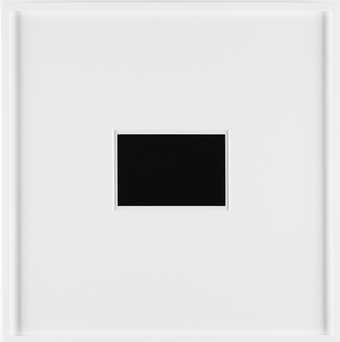
Fig.1
Katie Paterson
History of Darkness 2010
Black and white photograph, de-bossed mounts
Installation view Ingleby Gallery, Edinburgh 2011
Photograph © Ingleby Gallery
The work is ambitious and understated at the same time, a thought-provoking conjunction of the sublime subject, innovative technology, handwritten record, the inscrutable elegance of the image, and sheer visual repetitiveness. It seems to allude to the history of minimal art as well as the history of the universe, and compels reflection on the impossibility of ever achieving full knowledge, or of finding a way of recording what is known. ‘I think that there is never a way to represent, see or know all the darkness in the universe’, she remarks, ‘so it is a kind of infinite journey, and a futile one, to try to capture it on a human scale’.19
Paterson has described the speculative talk among the scientists at the observatory, as deep time appeared right there in front of them on the screen, and discussion of origins inevitably turns to that of a possible end. She heard them speak of ‘the Big Rip’, when all matter, from stars and galaxies to atoms, will be torn apart by the expansion of the universe. But what kind of art practice could hope to deal with such an incomprehensible domain? For her piece Inside this Desert Lies the Tiniest Grain of Sand 2010 she turned away from cosmic space to work at micro-scale:
I created a grain of sand on the nano-scale: that is, 0.00005 mm across, completely invisible. I took a grain from the Sahara Desert, then had it chiselled down using special techniques in nano-technology, to become almost nothing, but yet still a grain of sand. It was an invisible sculpture, but yet still present in time and space.20
She then returned it to the Sahara, and buried it among the desert sands, and later posted 500 postcards announcing ‘this small event’ to friends, family and random recipients. The work, therefore, combines a challenging concept, elaborate technologies, the play of metaphors, and a real (that is, complicated, arduous and expensive) journey to the Sahara, as well as the use of old-fashioned infrastructures such as the postal service.
Simon Faithfull’s work evinces a fascination with the surface of the globe, across which he traces symbolic lines and figures, and with the wilful colliding of grand, abstract ideas with awkward physicality or quotidian expressive vehicles. His projects have involved programmes of action that follow a relentless logic to some ultimately absurd end, documented in films in which the camera scrupulously records real-time events, and which on occasion are projected as illustrations to performances in which the artist takes on the guise of an explorer or geographical society lecturer.
Escape Vehicle No.6 2004 charts the upwards journey of a weather balloon from which has been suspended what appears to be an ordinary domestic chair, the progress of which is recorded by a camera attached to the balloon itself. The chair ascends quickly to the point where the curve of the earth and black space beyond are visible. In the artist’s own words: ‘You can just about make out this thin blue line at the edge of the planet that quickly fades to black. This is the space that we normally occupy. We’ve reached about 30 kilometres high now and already we are beginning to leave the atmosphere’.21 Thirty kilometres, he goes on to point out, is not that far, hardly a day’s walk. But at this height there is only a faint atmosphere and the temperature is minus sixty degrees, and the shortness of this journey reminds us of the relative thinness of our protective layer of air, and the fragility of our position in space. An empty chair in nineteenth-century pictorial symbolism stood in for the human figure, dead or absent, which habitually occupied it, and is here a further symbol of our vulnerability.
0.00° Navigation is another video piece in which the protagonist, the artist himself, follows an invisible but symbolically significant line, the Greenwich Meridian, from the point where it cuts the southern English coast at Peacehaven, across country, through villages, towns, then London and eventually via a caravan park near Cleethorpes, into the North Sea and presumably on to the North Pole (fig.2). The artist has described the appeal of this imaginary line, an entirely hypothetical construction:
A line built by Britain out of naval power and world domination but one that until recently was completely invisible. With the advent of GPS, however, you can now trace or feel it as its slices through the landscape … I was imagining myself as a kind of ghost following another phantom – a ghost-line. A very insignificant, unnoticed ghost following a much more powerful spook.22

Fig.2
Simon Faithfull
0.00° Navigation 2009
Video
55 min
© Simon Faithfull
The figure’s progress is, of course, richly comical, as he scales the emblematic white cliffs, goes through the garden of a bungalow, exits via a kitchen window, scrambles through brambles, scales fences, clambers over rooftops, goes through schools and garages, crosses a golf course, lakes and ditches. The banal, suburban landscapes of England are contrasted with ‘this epic line created by empire, this grid slung around the planet by imperial power’.23 There is an obvious allusion to the practice of Richard Long, and it might be taken as a parody of a work such as A Ten Mile Walk England across Exmoor – open moorland replaced by cluttered and commonplace spaces – were it not for the realisation that Long, too, had to commit himself to reckless trespass, and that there was a playful and provocative aspect to early British land art which has tended to be forgotten in later readings of that movement as environmentally affirmative and respectable.
The deadpan quality of 0.00° Navigation also alludes to the films of comic actor Buster Keaton. Faithfull has described it as ‘a kind of homage to Rail Rodder, a film that Keaton made right at the end of his life. In it Keaton swims out of the Atlantic on the east coast of America, accidentally traverses the complete landmass of Canada on a small railway buggy, and finally goes back into the water at the Pacific coast’.24 Journeys from one coast to another are also a staple of the repertoire of British walking artists such as Long and Hamish Fulton, but the reference here to film, comedy and popular culture introduces an element of unpredictability and hybridity into Faithfull’s environmental practice.
Jem Southam has established a strong reputation as a photographer of landscape since the publication of his first collection in the 1980s. His work is mostly organised in series, often open-ended, in which he records changes, both natural and man-made, in particular locations over considerable periods of time. He is interested in the narratives that run through any given environment, narratives that can be historical, as in his first publication The Floating Harbour: A Landscape History of Bristol City Docks, or geological, as in his studies of coastal erosion, cliff falls and sand bars.25 Sometimes the focus is on the activities of a small group of individuals, such as the well-meaning but misguided attempts of local ‘improvers’ to ameliorate a former industrial site in the Devon village of Upton Pyne, and sometimes on the larger ravages of industry, as in Red River and his work on the Cumbrian coast, where the rocky shoreline has been turned into solid metal as a result of molten slag being tipped there from the nearby steelworks.26
Southam favours a very large format analogue camera, in essence equipment comparable to that used by earlier photographers, which at first sight seems to make his work an extension of a long tradition of topographical or documentary image-making. On the face of it, aspects of his method and vision appear to have something in common with the work of filmmaker Patrick Keiller: the same dedication to cumbersome equipment and a willingness to accept the constraints that this imposes, the same preference for working alone in the field, the same intense scrutiny turned on the landscape, with each carefully framed shot loaded with inexhaustible detail. Both have a respect for a certain kind of rigorous pictorialism, and a wariness towards the Picturesque. Both believe that much of the meaning of the world can be apprehended through the way it looks, and that looking is a mode of critical analysis that can reveal far more than what lies on the surface. Both are aware of the politics of landscape, and the stories that are threaded through it.
Yet there are connections in Southam’s work with some of the other artists who have been the subject of enquiry in this programme. There is his strong feeling for the sculptural, for example, so that the forms of dewponds or rockfalls can come to seem like the work of anonymous sculptors, even as a kind of land art. There is an unexpected affinity, too, with Paterson’s History of Darkness, for all that he is working with a traditional medium and that her interests are in conceptual art, performance and installation: a certain quality of melancholy, and an awareness of how limited our knowledge is, how difficult it is to be sure of anything.
This uncertainty comes across in his discussion of his most recent project, to photograph the River Exe and its tributary system. It begins with a simple question: what is a river? Southam had made rivers his subject before, but the origins of this new project are unexpected: a conversation about an experiment to throw light on the neurological development of children between the ages of five and eleven by asking them to make a drawing of a river (fig.3). He describes how he tried this experiment himself, and persuaded around ten local children aged between about seven and twelve to ‘draw a river’:
It was a very small sample but the results were fascinating. Most of the drawings showed a small river flowing from the top right across the horizontal sheet to the bottom left. All the drawings included trees and foliage and a series of small round shapes either within or next to the stream. I was puzzled as to what these represented for a while, until I realised that all the children of our street would, if they went out for a walk with their family, in all likelihood go to Dartmoor. The streams of Dartmoor are strewn with small granite boulders and rounded pebbles. So when asked to draw a river the children had responded by pulling from their imaginations pictures that corresponded to their direct experiences … Only one drawing featured tributaries, but the angle at which they met the main stream was against the flow of the river. When I asked about this, the child explained that they understood something of a river system, and when pressed on the matter of the angle of address, they explained that water flowed down the main stream and then UP the tributaries.27
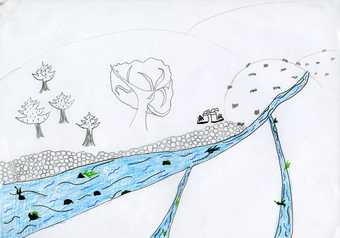
Fig.3
Anonymous child aged 12
A River 2006
Coloured drawing
Photograph © Jem Southam
The drawings might be found charming for what they said about children’s naive understanding of the world and their capacity to express their knowledge in visual form. But Southam felt that they raised a deeper point: ‘could any of us say with confidence that we know what a river is, or could or we come up with a comprehensive definition? … A river, any river, even one as small as the Red River, is beyond our powers of understanding’.28
Southam turned to his own medium of photography in search of a definition of what a river is, choosing the Exe because it was his local river, and walking its banks to determine possible locations, but without any clear idea as to what the content, form or structure of the finished work might be, or indeed if the work could ever be resolved, ‘since I was not aware of any model that might suggest a structural resolution’.29 Right from the start, some formal and technical aspects – camera, lens, film etc. – had to be decided, considerations that would in themselves have far-reaching implications for the conceptual development of the ensuing work as well as its visual character:
Early on I started using a lens that rendered, even with this system, an exceptional degree of peripheral detail. This led me to pay more forensic attention to the myriad narratives that a view contained. In one photograph [fig.4], for example, a thin line of ice follows the bank of the river, a large dog has recently made its way onto the soft sand of the bank, the river level has recently receded five or so inches leaving a small ‘tide’ line of fine twigs, and two light stalks are all that remains visible from the profusion of towering and invasive Himalayan Balsam plants that grew here over the summer, while twisted through the lower hanging branches at various levels are clumps of organic material left from the earlier autumn floods, and on the higher branches of the alder trees that lean over the river hundreds of dark dots that are the remains of last year’s fruit.30
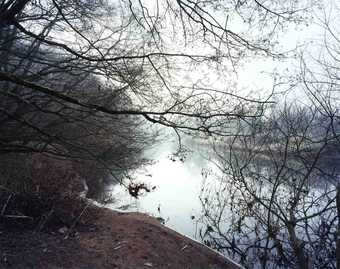
Fig.4
Jem Southam
River Exe 2010
Photograph
© Jem Southam
Here is that intense scrutiny that is also found in Keiller’s films, comparable to his long-held shots of roadside flora, though the ‘narratives’ referred to by Southam are less evidently metaphorical or political.
Other aspects of the project’s methodology and content began to emerge: revisiting locations and re-photographing them at regular intervals over extended periods of time, the issue of access (which on non-navigable rivers in Britain can be very restricted), the question of structure, form and ultimate outcome. But each decision, each new photograph taken, only raises further questions and anxieties as the full complexity of the task ahead is gradually disclosed. There are so many reaches of the river, so many tributaries, springs and sources; it seems an ‘impossible task … a quagmire of a problem, from which I see no viable release’.31
From this perspective, a river presents as much of a challenge to the artist as does the darkness of ‘anterior time’ that Paterson has taken as her subject. Southam’s pursuit of the elusive phenomenon of a river and Paterson’s discovery that ‘ancient darkness’ can be made visible have both given rise to projects that could be life-long, and to the creation of archives that are potentially infinite. The objects of their enquiry may be literally more than poles apart, but nothing could more vividly indicate the expanded terms in which artists might now engage with the world.
Patrick Keiller’s feature-length film Robinson in Ruins (2010) was the centrepiece among the artistic projects presented at ‘Art & Environment’; appropriate given that it was produced under the auspices of the AHRC’s Landscape and Environment programme itself. Elsewhere in this issue of Tate Papers, Stephen Daniels, Doreen Massey and Patrick Wright introduce the background of the film and the wider project of which it was part. Robinson in Ruins traces a journey following a roughly elliptical circuit around Oxford, across luminous pastoral landscapes which are nonetheless shadowed by economic crisis and an impending ecological collapse. Two other contributors to this issue also engage with the film, concentrating on its motif of ruin. Matthew Flintham was a part of Keiller’s research team, though working on a theme of his own, militarised landscape, which intersects the filmmaker’s concerns rather than coincides with them entirely. Flintham’s contribution ranges widely over recent British and American art practice and argues that art is a legitimate and productive means of responding to militarised spaces, despite the obvious difficulties they present. He brings out the analogies he sees in Keiller’s film between earlier historical enclosure movements and the large-scale appropriation of land by the military in the twentieth century. He also dwells on the physical ruins that are the legacy of such an occupation: urgently built, highly specialised structures that soon become redundant, and are then left to slow decline.
Finally, Brian Dillon’s paper focuses as much on the metaphor of ruins as on their physical persistence. He takes Robinson’s rapt gaze on pastoral subjects – landscapes with ruins – as an indication that the English countryside has become ‘a monument to itself’, a symptom of a problematic nostalgia, associated with a tradition of English ruin aesthetics. But he also seeks to define Keiller’s own position as part of a broader and more critical European tradition in which ‘ruin lust’ can just as well imply fantasies of the future as of the past, an anticipation of coming ruination. In this light, the extended, almost exaggerated shots of foxgloves, thistles and poppies that have given rise to so much comment elsewhere, are suggestive of an ecology that is ominous rather than reassuring.

